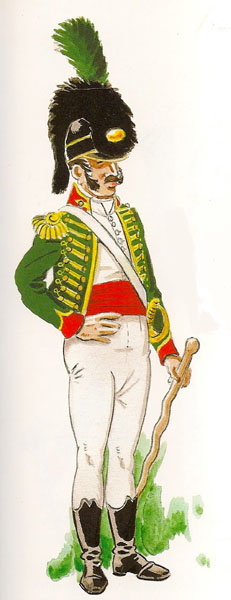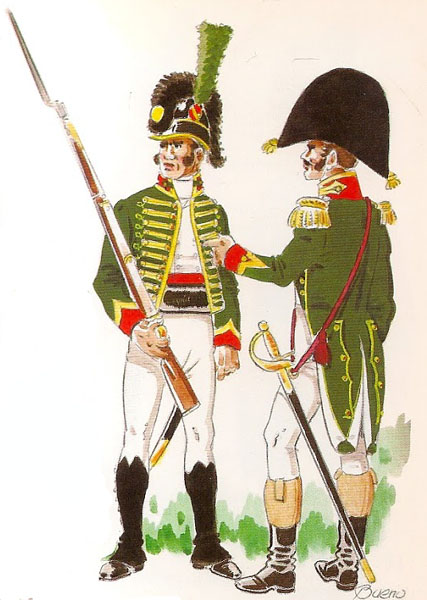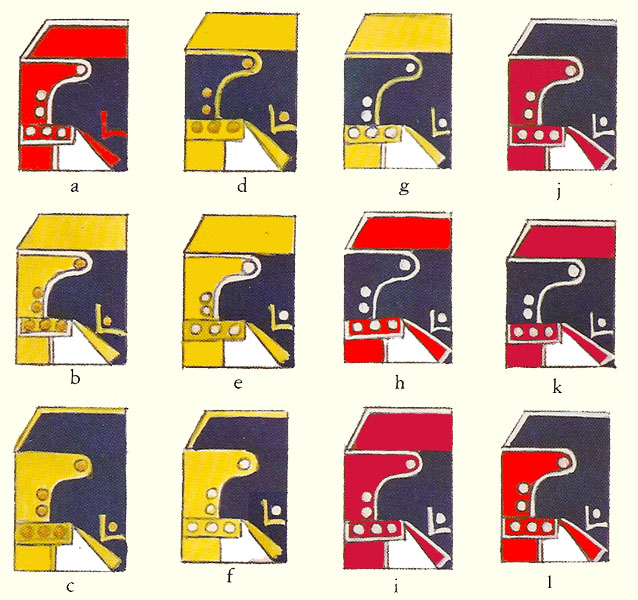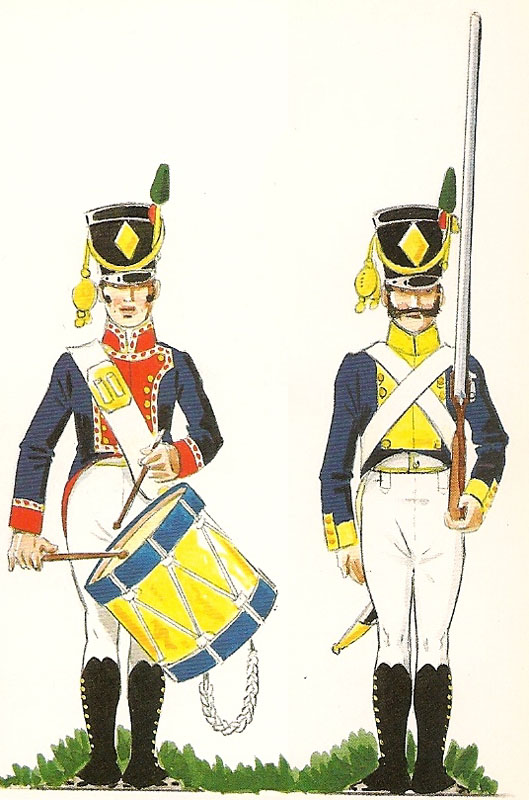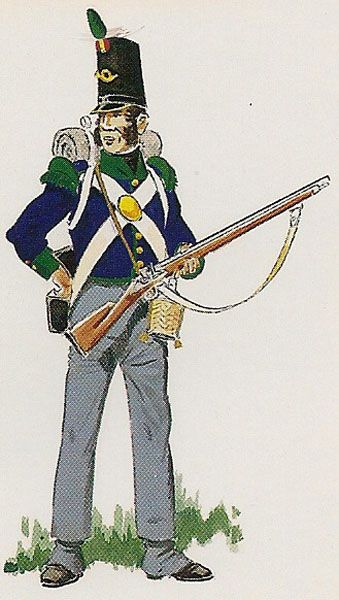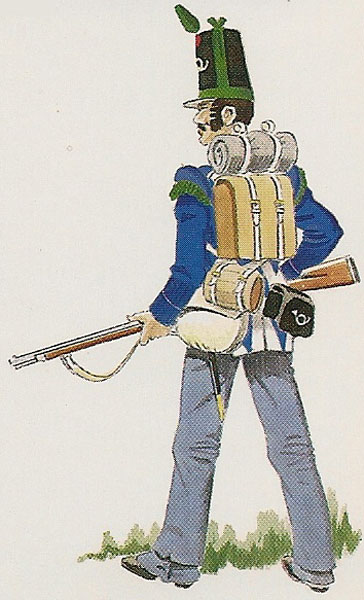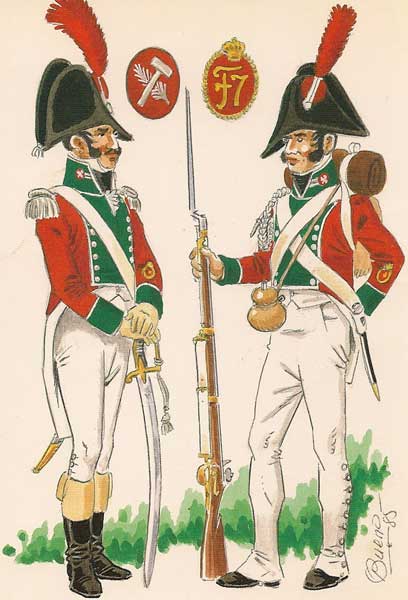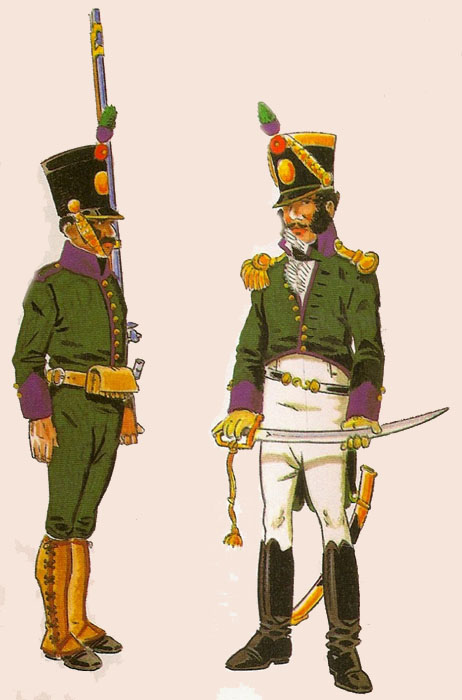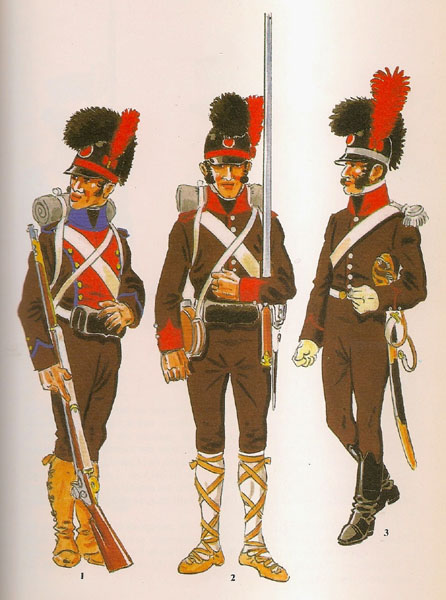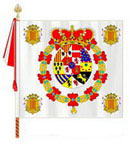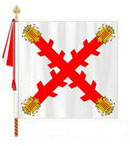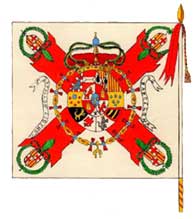|
Spanish Light InfantryOrganisationThroughout the Napoleonic Wars, the light infantry were organised as single batallions, unlike the line infantry which had multi-batallion regiments. 1 May 1808On 1 May 1808 the light infantry consisted of 12 batallions:
Each battalion had a wartime establishment of a staff of 9 and 6 companies of 206 for a total strength of 41 officers and 1204 men. The battalion staff included an ensign standard bearer (abanderado) which suggests that the light infantry carried standards at this time. Each company had 3 drummers (tambor). These battalions appear to have had an actual strength that was up to their establishment. All battalions had a strength in excess of 1000, except 2º DE CATALUÑA which had 726. May to December 1808From May to December 1808, 48 new light infantry units were created:
1809During 1809, 62 new light infantry units were fielded, 16 of which were created that year:
1810In July 1810, it was decreed that the infantry organisation was in need of a reform, after the creation of all these new units. The light infantry was to consist of 32 battalions. This does not seem to have been fully completed, as in addition to the original battalions there were still 37 new units:
The decree of July 1810 left the light infantry battalion organisation basically unchanged with a wartime establishment of a staff of 9 and 6 companies of 206 for a total strength of 41 officers and 1204 men. however the proportion of NCO's had been increased. In October, 2 buglers (cornetas) replaced 2 of the 4 drummers in each company. During 1810, 46 new light infantry units were fielded, 9 of which were created that year:
1811During 1811, 65 new light infantry units were fielded, 19 of which were created that year:
The two new CATALUÑA battalions were formed as "twins" of the original 1º DE CATALUÑA battalion. 1812During 1812, 65 new light infantry units were fielded, 8 of which were created that year:
By decree of 8 March 1812, battalions of line and light infantry were to have the same organisation consisting of: a staff , 1 grenadier company, 6 fusilier companies and 1 light company. The staff had an establishment of 11 and each company of 122. Attached to the grenadier company, were 7 sappers (gastadores) including a corporal. Thus the battalion had 944 men. Although it did not become official until 1833, it seems probable that the light infantry even then used the terms tirador for fusilier, carabinero for grenadier, and cazador for light company. It seems probably that they continued to use buglers instead of drummers, as per the 1810 decree, even though it was not mentioned in the 1812 decree, but was again stated in the 1815 decree. 1813During 1813, 55 new light infantry units were fielded, no new units were created that year. 1814During 1814, no new units were created. 63 light infantry battalions were fielded, 9 original and 54 new. 9 original light infantry battalions :
54 new light infantry battalions :
Uniforms1802In 1802 a green hussar style uniform was decreed for all light infantry battalions. The 1802 light infantry uniform was a green hussar style jacket with yellow braid and brass buttons. The collar and cuffs were red, piped yellow. This was worn with a red sash and white waistcoat and breeches. The headgear was a black leather Tarleton style helmet with fur crest and a green plume above the Spanish red cockade. Footwear was black gaiters and shoes, but these were often replaced by Spanish traditional sandals (alpargatas). A black ventral (belly) cartridge pouch was worn. A short brown cloak was often worn over then left shoulder. Officers: The officiers' coat could be the same style as that of the private but better quality, worn with epaulettes, braid and buttons in gold and the red sash. Alternativly they could wear a long tailed green coat with red collar and cuffs. Epaulettes, buttons and piping round the collar, cuffs and lapels were gold. Officers wore green or white hussar style breeches and boots. Officers headgear could either be the helmet or a bicorne with a green plume above the Spanish red cockade. Drummers: Nothing is known about the drummers' uniform, but if it followed the normal Spanish practice for hussar style uniforms, the jacket could be expected to be the same as that of the private but in red. Alternativly Suhr shows a musician with a jingling johnie wearing regulation uniform but with the jacket in blue with red collar and cuffs.
1805On 15 April 1805, it was decreed that the hussar style uniform should be replaced by a uniform in the same style as the line infantry. To quote Charles J Esdaile: the light infantry were deprived of the simple and practical costume by which they had hitherto been characterised in favour of the conventional bicorne and tailcoat of the rest of the army. The result, as a later critic noted, was that the cazador became impeded by "a stiff cravat that does not let him turn his head, a coat whose useless tails get caught on branches, a cartridge box that continually bangs against him, a sabre that gets between his legs, tripping him up at every instance, and above all a pack that impedes his progress even when walking normally." By the start of the war in 1808, not all battalions had received the 1805 uniforms and some were still wearing the 1802 hussar style uniforms The 1805 light infantry uniform was a dark blue long-tailed coat in the same cut as for line infantry. The collar, cuffs, turnbacks and piping were in the individual regimental colour (Red, Crimson or Yellow). Buttons were brass or white metal. The waistcoat and breeches were white and the gaiters were black. The headgear was a black felt bicorne with the red Spanish cockade and green plume. A short brown cloak was often worn over then left shoulder. The infantry were armed with a musket and bayonet. The musket could be a shorter version or the Catalan Escopeta.Sergeants: Throughout the period, sergeants wore the same uniform as the rank and file distinguished by worsted fringed epaulettes in facing colour; two for the first sergeant and one on the right shoulder for the second sergeants. They had a short sword but were otherwise armed with musket and bayonet, unlike the English army where 7-foot pikes (aka halberd) were still in use. Officers: The officiers' uniform was that of the private but better quality, worn with epaulettes and buttons in gold or silver depending on button colour. They wore white breeches and boots. Their headgear was a bicorne with a green plume above the Spanish red cockade. Drummers: Drummers wore the same as that of the private but in with red facings (regardless of the battalion's facing colours) and red-and-white lace.
1807 Romana's CorpsRomana's Corps was sent to support the French in northern Europe and contained 2 light infantry battalions: 1º Voluntarios de Cataluña and 1º Voluntarios de Barcelona. The uniforms of Romana's Corps were well documented by the Suhr brothers when they were in Hamburg in late 1807 before moving to Denmark in early 1808. Both regiments arrived in Hamburg wearing the 1802 uniforms but received 1805 model uniforms while they were there. The new uniforms and equipment came from Paris. They were still wearing these 1805 uniforms when in August 1808 they boarded British ships and were returned to the Peninsular. 1º Voluntarios de Cataluña: The main difference from the 1805 regulations was a French style bell topped shako with gold plate and cords with a green plume over the red Spanish cockade affixed to the left side of the shako. 1º Voluntarios de Barcelona: The main difference from the 1805 regulations was a shako in the style of the cazadores a caballo. It had a silver plate and cords with a green plume over the red Spanish cockade afixed to the left side of the shako.
1811On 12 December 1811, new uniform regulations were issued. Both line and light infantry were to have uniforms of the same cut; a short single-breasted coat worn with shako, trousers and short gaiters underneath the trousers. The coat was blue and had collar and cuffs in sky-blue, white turnbacks and white metal buttons. Trouser were to be Light Blue. The shako was a truncated cone shape with a small "tuft" plume above the Spanish red cockade, the same model shako as worn by the British light and rifle regiments. Some shakos were plain and some were adorned with lace. Tirador or fusilier companies had a white tuft, white shako lace and a brass rampant lion shako plate. Carabinero or grenadier companies had a red tuft, red shako lace and a brass grenade shako plate. Cazador or light company had a green tuft, green shako lace and a brass or silver (sources differ) bugle horn shako plate. The carabinero and cazador companies were distinguished by wings in the British fashion with red or green fringes respectively. These uniform regulations were hard to follow, as most of the uniforms worn by the Spanish were shipped from England, and the Spanish often referred to this regulation as the "English Uniform". There was both Dark Blue and Light Blue uniforms. The dark blue were in the majority, and Wellington had these shipped to units in the North of Spain. The light blue uniforms went to units in the South of Spain via Cadiz. Officers: The officiers' uniform was that of the private but better quality, worn with epaulettes and buttons in silver and a gilt gorget. They wore white breeches and boots replace my trousers of coat colour or grey on campaign. They could wear a shako with the same colour lace as their company or with gold lace with the company colour tuft. Instaed of the shako, their headgear could be the bicorne with a company colour plume above the Spanish red cockade. One of the reasons for the regimental officers' bicorne going out of fashion in the field, was that it made it easy for enemy sharpshooters to target officers with more than their fair share of bullets. By 1811 the wearing of a bicorne by a regimental officer was so rare that doing so cause it to be remaked upon in memoirs. Buglers: Buglers wore the same as that of the private but with wings in white or red.
Non-Regulation 1808-1814Many of the units formed in the chaos after The 2nd of May had uniforms that were not regulation. Even after the 1811 regulation, many units still had non-regulation uniforms and none of the illustrations shown above for the 1811 uniforms are 100% regulation. The ubiquitous brown Spanish cloth was often used for uniforms and even occasionally British red cloth. The bicorne went soon out of fashion, and as well as the regulation 1811 shako even round "top" hats or French style bell-topped shakos were used. The French style shakos caused recognition problems, especially when troops were wearing greatcoats and shako covers, when the Spanish and French troops would have the same silhouette.
1814The following shows uniforms as they were recorded in 1814.
FlagsPrior to 1802 a battalion carried two 1762 pattern colours: one Coronela with the royal coat of arms on a field of white and one Sencilla with the red cross of Burgundy on a field of white. The obverse (or front, when the stave is to the left) had the royal coat of arms shown normally while the reverse (or rear, when the stave is to the right) had the royal coat of arms reversed. The Royal Decree of 1802 set the number of flags to one per infantry battalion. From that time on, the light infantry battalions carried the Coronela and the excess colours were often placed in storage in churches. It was common practice for newly formed units to do one of the following:
As the war progressed and flags needed to be renewed, some units used a special model, which combined the design of the Coronela and Sencilla, with the Royal Coat of Arms on top of the red cross of Burgundy. However, whether the light infantry actually carried these colours on campaign is uncertain.
Sources
|


